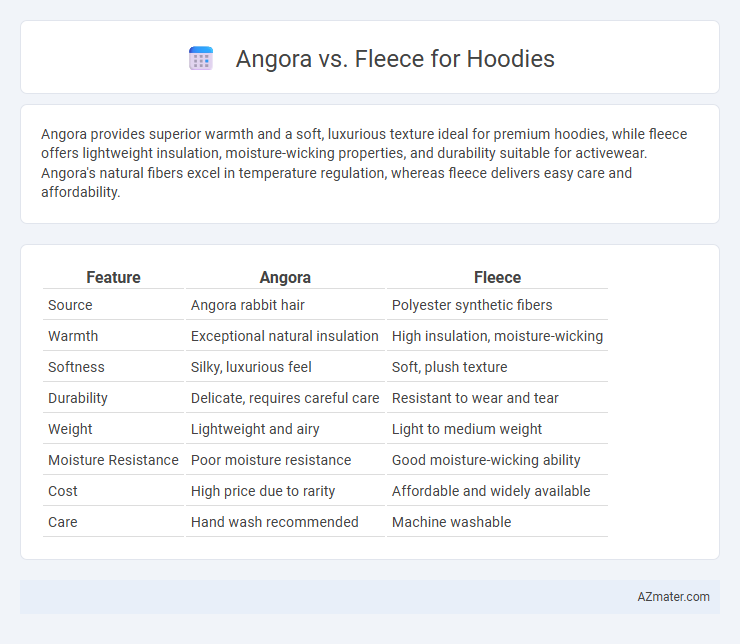Angora provides superior warmth and a soft, luxurious texture ideal for premium hoodies, while fleece offers lightweight insulation, moisture-wicking properties, and durability suitable for activewear. Angora's natural fibers excel in temperature regulation, whereas fleece delivers easy care and affordability.
Table of Comparison
| Feature | Angora | Fleece |
|---|---|---|
| Source | Angora rabbit hair | Polyester synthetic fibers |
| Warmth | Exceptional natural insulation | High insulation, moisture-wicking |
| Softness | Silky, luxurious feel | Soft, plush texture |
| Durability | Delicate, requires careful care | Resistant to wear and tear |
| Weight | Lightweight and airy | Light to medium weight |
| Moisture Resistance | Poor moisture resistance | Good moisture-wicking ability |
| Cost | High price due to rarity | Affordable and widely available |
| Care | Hand wash recommended | Machine washable |
Introduction to Hoodie Materials: Angora vs Fleece
Angora and fleece are two popular materials used in hoodies, each offering distinct qualities in warmth and texture. Angora, made from the hair of Angora rabbits, is renowned for its exceptional softness, lightweight warmth, and natural insulation properties. Fleece, typically crafted from synthetic fibers like polyester, provides excellent moisture-wicking abilities, quick drying, and durability, making it ideal for activewear hoodies.
What is Angora? Overview and Characteristics
Angora is a luxurious fiber obtained from Angora rabbits, prized for its exceptional softness, lightweight warmth, and silky texture, making it a premium choice for hoodie materials. Known for its excellent insulation, Angora fibers are hollow, providing superior heat retention while remaining breathable and moisture-wicking. This natural fiber also has a distinctive fluffy appearance and slight halo effect, enhancing the aesthetic appeal and comfort of hoodies crafted from Angora compared to traditional fleece.
Understanding Fleece: Fabric Features and Benefits
Fleece fabric, made from synthetic fibers like polyester, offers superior warmth, moisture-wicking properties, and lightweight comfort, making it ideal for hoodies in cold weather. Its breathable and quick-drying nature enhances durability and ease of care compared to natural fibers. Fleece hoodies provide excellent insulation while maintaining softness, ensuring both comfort and functionality.
Softness Showdown: Angora vs Fleece Texture
Angora excels in softness with its fine, silky fibers derived from Angora rabbits, providing a luxurious, smooth texture that feels incredibly gentle against the skin. Fleece, though less fine, offers a plush, cozy texture characterized by its insulating and moisture-wicking properties, making it ideal for warmth and comfort. When comparing softness, Angora's natural fiber delivers unparalleled smoothness, while fleece emphasizes softness blended with durability and thermal efficiency.
Warmth Comparison: Which Hoodie Material Insulates Better?
Angora fiber, derived from Angora rabbits, is renowned for its exceptional softness and natural insulation properties, trapping heat effectively to provide superior warmth in hoodies compared to traditional fleece. Fleece, typically made from synthetic polyester, offers excellent moisture-wicking capabilities and breathability but may lack the same level of thermal insulation as Angora. Therefore, Angora hoodies generally insulate better in cold weather due to their unique fiber structure and higher heat retention ability.
Breathability and Moisture-Wicking: Angora or Fleece?
Angora excels in breathability due to its natural fiber structure, allowing better air circulation and maintaining comfort in moderate temperatures. Fleece, made from synthetic fibers, offers superior moisture-wicking capabilities by drawing sweat away from the skin and drying quickly, ideal for high-intensity activities. For a hoodie that balances breathability and moisture management, fleece provides enhanced performance in moisture control, while Angora offers a softer, more breathable option for everyday wear.
Durability and Longevity: Which Material Lasts Longer?
Angora offers exceptional softness but tends to be less durable than fleece due to its delicate fibers, which can wear down with frequent washing and daily use. Fleece, made from synthetic polyester, excels in durability and maintains its shape and quality over time, making it ideal for long-lasting hoodies. For longevity, fleece hoodies generally outperform angora ones, especially in active or outdoor environments.
Care and Maintenance: Washing Angora vs Fleece Hoodies
Angora hoodies require gentle hand washing or delicate machine cycles using cold water and mild detergent to prevent fiber damage and matting, while fleece hoodies are machine washable, durable, and dry quickly without special care. Avoiding heat exposure and excessive friction preserves Angora's softness and prevents pilling, whereas fleece resists pilling and shrinking under normal washing conditions. Proper drying methods like flat drying for Angora and tumble drying on low for fleece further extend the lifespan of both hoodie materials.
Ethical and Environmental Considerations
Angora wool, sourced from Angora rabbits, raises ethical concerns due to animal welfare issues, including stress and harm during harvesting, while fleece, typically made from polyester, contributes to plastic pollution and non-biodegradable waste. Angora production often involves intensive animal handling, whereas fleece manufacturing relies on synthetic fibers derived from fossil fuels, impacting carbon emissions and microplastic release. Choosing between Angora and fleece for hoodies requires weighing animal rights against environmental pollution, with organic or recycled fleece and certified cruelty-free Angora as more ethical alternatives.
Angora vs Fleece Hoodie: Which Is Right for You?
Angora hoodies offer exceptional softness, warmth, and a luxurious texture derived from Angora rabbit fibers, making them ideal for those seeking premium comfort and insulation. Fleece hoodies provide lightweight durability, moisture-wicking properties, and excellent breathability, suitable for active lifestyles and cold-weather layering. Choosing between Angora and fleece depends on your preference for natural fiber luxury versus synthetic practicality and versatility in hooded apparel.

Infographic: Angora vs Fleece for Hoodie
 azmater.com
azmater.com